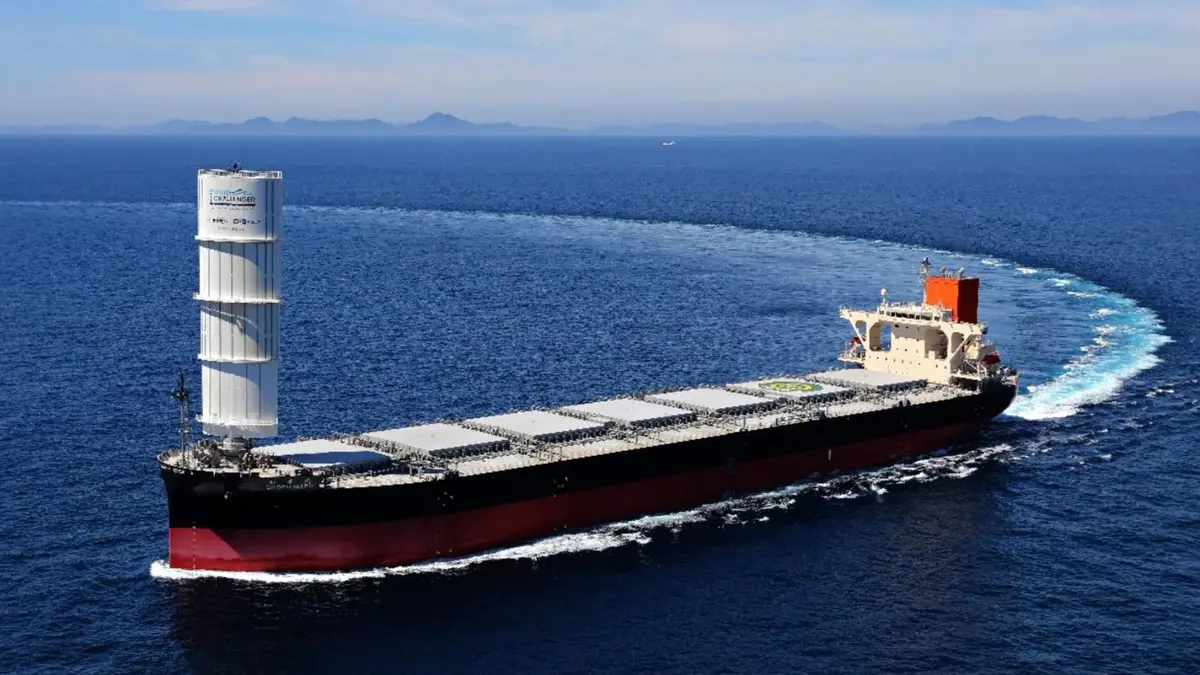The World’s Largest Wind-Powered Cargo Ship Makes Historic First Atlantic Crossing!
The world’s largest wind-powered cargo ship recently completed its first transatlantic delivery, marking a significant milestone in sustainable shipping. The ship, designed by the French startup TransOceanic Wind Transport (TOWT), carried hundreds of pallets of champagne, wine, and cognac from France to New York.
This voyage was the first time in nearly a century that a large cargo ship powered almost entirely by wind crossed the Atlantic. TOWT believes that wind-powered ships can be a viable alternative to traditional cargo ships that run on fossil fuels.
Guillaume Le Grand, cofounder and president of TOWT, highlights the advantages of modern technology, such as advanced meteorological models, satellite communications, and routing intelligence, which make wind a reliable source of propulsion.
The startup’s first ship, named Anemos, differs significantly from traditional sailing ships. It incorporates design elements from racing sailboats, such as carbon fiber masts that are lightweight and taller than traditional wooden masts. This allows the ship to hold larger sails that can catch more wind.
Unlike traditional sailing ships, Anemos uses a mechanized system to deploy its sails. This system is advanced enough that all seven sails, covering 3,000 square meters, can be controlled remotely. Despite its size, which is slightly larger than the famous British clipper ship Cutty Sark, Anemos requires only seven crew members, compared to the 48 sailors needed to operate the Cutty Sark.

To maximize the use of wind power, TOWT developed custom routing software. The ship also has backup diesel-electric engines that can be used when wind conditions are not ideal. However, these engines are used sparingly, with the ship relying on sails for about 95% of the journey.
Initial delays during its first trip forced Anemos to use fuel when leaving France, but the last ten days of the journey were powered entirely by sails. TOWT’s approach to unloading cargo is also more efficient than that of traditional container ships, which often sit at ports for days before being unloaded. As a result, the total delivery time can be faster, even though Anemos has a smaller cargo capacity compared to modern container ships.
When the wind is strong, Anemos’ propellers can spin in reverse, generating power from the ship’s movement through the water. This energy can be used to run onboard electronics, including kitchen appliances and ventilation systems.
While shipping costs on Anemos are slightly higher than those on standard container ships, TOWT offers long-term contracts with stable pricing, avoiding the fluctuations that come with diesel or fuel oil.
Several brands are already using TOWT’s service to meet climate goals. These companies are willing to pay a premium for wind-powered shipping because it helps them reduce their carbon footprint and serves as an attractive marketing point. Some brands add QR codes to their product labels, which link to data about the carbon savings achieved during shipping.
TOWT argues that wind power is a more immediate and reliable solution for decarbonizing shipping compared to alternative fuels, which are often touted as the industry’s future.
Le Grand criticizes the shipping industry for delaying serious action on decarbonization, relying on the hope that cheap, efficient, and truly green fuels will soon become available. He points out that some of the current so-called solutions, such as liquified natural gas, may actually worsen pollution due to methane leaks.
Currently, TOWT operates two ships and plans to conduct monthly transatlantic crossings. After delivering wine and spirits from France to the U.S., the ships will head to South America to pick up coffee for delivery back to Europe.
TOWT has ordered six more vessels, which are expected to be operational by 2026, and the company envisions a future fleet of hundreds of wind-powered cargo ships.
To support this expansion, TOWT is working with industry associations to establish formal training programs for modern sailing cargo captains, a role that currently lacks standardized training.
The success of Anemos and TOWT’s growing fleet represents a promising step toward more sustainable shipping practices. By leveraging wind power, TOWT is not only challenging the dominance of fossil-fuel-powered cargo ships but also demonstrating that sustainable alternatives are viable today.

